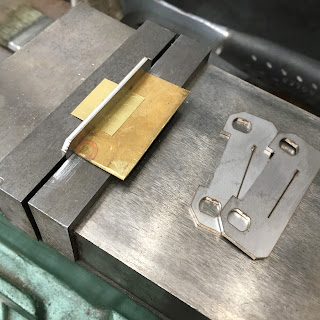One last part to bring the project documentation up to date. I recently got access to a 3D printer and I thought that I would give it a try to see whether it is useable in production or not. I've avoided buying/building one of these as I have been sceptical about the utility of the parts that one can produce. The massive upside of the process was being able to go from zero drawings to finished part in roughly two hours - which included tackling the learning curve of the software! Print time for this lever rest was around half an hour. Not great for production of large parts, but feasible for a small run of this part.
Part, sitting on a support raft, roughly 75% done.
Finished!
Close up back at the shop - clean up was really easy: a quick scrape with a utility knife...
A perfect fit first time. I tested it at operating temperature (another worry I had about the plastic) and there is no softness immediately apparent. This shot also shows the latest stainless parts installed with the correct hardware. Now I just need the foundry to finish and send me the second (and, I hope, final) iteration of the group body - I ordered it in mid-August and they have been really slow. About a week ago they informed me that they had scrapped the casting during machining. (Deep sigh). I don't want to machine the remaining piston parts until I receive it.
Part, sitting on a support raft, roughly 75% done.
Finished!
Close up back at the shop - clean up was really easy: a quick scrape with a utility knife...
A perfect fit first time. I tested it at operating temperature (another worry I had about the plastic) and there is no softness immediately apparent. This shot also shows the latest stainless parts installed with the correct hardware. Now I just need the foundry to finish and send me the second (and, I hope, final) iteration of the group body - I ordered it in mid-August and they have been really slow. About a week ago they informed me that they had scrapped the casting during machining. (Deep sigh). I don't want to machine the remaining piston parts until I receive it.









































